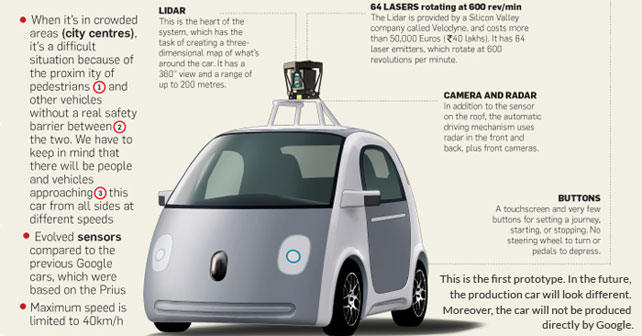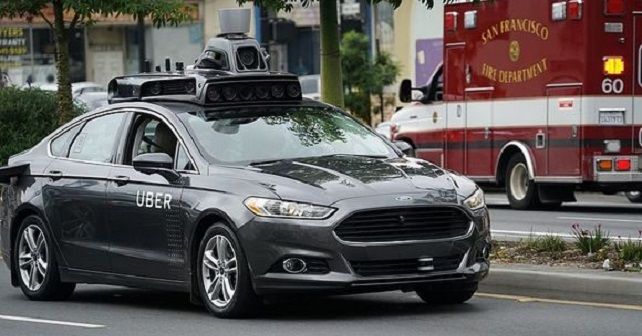Google Driverless Car
Don’t let the cartoon-esque rendering of this bug-eyed car fool you, as the Czar of the virtual world, Google has plans to revolutionise the way we
Don’t let the cartoon-esque rendering of this bug-eyed car fool you, as the Czar of the virtual world, Google has plans to revolutionise the way we perceive the automobile by building a self driven car without, wait for it, a steering wheel.
In some ways, this was to be expected. The company that redesigned the home page of the web to a much simpler form – a blank page, search string, and a little drawing – has invented what could be referred to as the easiest car in the world. It doesn’t have a brake pedal, or even an accelerator. The rear bench? Missing. The radio is nowhere to be seen. The glove compartment? Gone. The rear view mirror is relegated to an abandoned garage of memories. Above all, the fundamental appeal is absent, and that inescapable, inevitable component that we’re so accustomed to seeing in a car – the steering wheel – is also missing. So, at this point, we must ask ourselves, is the Google car really the future of the automobile? Is the Google car – which has a maximum speed of 40km/h, courtesy of a small electric motor – even a car?
The question is not as trivial as it might seem at first sight. Sergey Brin, who inspired the driverless car project (and also happens to be a Google co-founder, along with Larry Page) believes that this car will improve peoples lives by transforming mobility – finally offering a way to move around independently. Brin said, “What I’m excited about is how we could change transportation today for people who are too old, too young, or disabled, and can’t get around.” With the help of a smartphone app, the car is at your service and can pick up passengers and take them to their destination.

Travis Kalanick revealed that he’s a big fan of self-driven cars. He’s the founder and CEO of Uber Technologies, the company that allows people to order taxis and private town cars via a smartphone app, and he believes that this koala-faced car will be a game changer. “I unconditionally love cars that automatically drive themselves. Uber is expensive because we have to pay for the driver. If the driver is no longer there, using our service will become more economical than owning a private car.”
At Google, this project is headed by Christopher Urmson – a former Carnegie Mellon University roboticist. His perspective is, “The possession of a car makes no sense anymore. As a resource that actually stands still for 95% of the time, it represents a bad investment of a buyer’s money. And even when it moves, it creates accidents, because the driver at the helm cannot guarantee constant care and attention.” Understanding what Google is suggesting for the future is difficult due to media reports. Despite the many years of effort and money invested into the project, and despite the potentially revolutionary scope of the idea, every interview, every article, every question about the meaning of the no-driver program (and the technology behind it) is indignantly against Google. But one has to understand that Google does not want to confine their ideas to a chauffeur service in urban areas, but intends to overturn the very business model – which is based on the idea of vehicles being driven by humans – on which the car industry rests and thrives on. So, the idea is far more complicated than it appears.
The knot of responsibility
Google hasn’t been the lone voice to raise concerns over the imperfect human behind the wheel. Many car manufacturers, especially the German carmakers, are working on how to improve safety. But to deal with the elimination of the notoriously imperfect human being behind the steering wheel raises a series of issues that Google alone isn’t able to deal with. Infrastructure, for example – if the cars on the roads are all alike, designed to move like red blood cells, or packets of bytes on the digital highway, the physical highways must be equipped as such. A transport system must be invented from scratch, where the traffic consists of self-driving vehicles, and is controlled by big brother who oversees the risk of individual manoeuvres. How many countries can afford such a thing? Only the first world economies, one might say. And the others? This level of safety would be denied to poorer nations – is that fair?
Everybody knows, as well, that one of the major obstacles to the spread of these assisted driving cars will be the assignment of fault in an accident. The technology may already be approaching 99.9% reliability, but what about the remaining 0.1%? The whole concept of civil society, with all that it implies (laws and regulations, but also ethics), is based on the exercise of one’s rational awareness: sticking a mechanical element in this equation, however sophisticated it may be, would impose a global rethinking of the complex system that governs our lives as citizens.
The denial of freedom
Driving a car is a very personal experience, and this passion and enthusiasm could all be lost if everyone follows in the Google Car’s footsteps. Google will, no doubt, need a partner to manufacture these cars. But, by removing the human element, not many automakers will line up because cars are more than just a means of transport. Cars are objects through which one expresses one’s personality – through the choice of models, colours, even the engine and bodywork. There are many tiny universes in which we want to live alone – cubicles, offices, and other such oasis of tranquillity. They represent our status. Plus, cars are synonymous with freedom, liberation and independence in a world where approval reigns supreme.
This is where the Google Car acts like a buzz-kill. Are you sure Mr. Brin that the world is willing to sacrifice this freedom of expression?
TECHNOLOGY
MANY SENSORS, NO CONTROL AT ALL
It differs from previous driverless cars, because this one is electric and has no steering wheel and pedals. There is still confidentiality on the new sensors and software, which have evolved further


THE PROJECT MANAGER SPEAKS
Chris Urmson, the head of the project, announced on the company’s blog that, at the end of the summer, they would begin to test the first prototypes. Unlike this one, the new prototypes will still have a steering wheel and pedals – to allow the testers to intervene in case of a failure. Then, within two years, there will be another test with a hundred prototypes with no controls at all. “If the technology develops as we hope, we will work with partners to disseminate this solution safely,” says Urmson.
“These are basic electric vehicles. For now, we have limited the speed to 40km/h. There are a couple of buttons for starting and stopping, lots of space on board, and a screen that indicates the way. Nothing more than that. “

WHAT’S GOOD
• A strong push for assisted driving electronics is motivated by the search for higher security. Today most accidents happen because of human error
• More people will have the ability to stay mobile
• It will kill the pleasure of driving of course, but traffic will be more orderly
WHAT’S NOT
• Driving in the developing world is far more complex than in typical American small towns and on highways, so will the driverless car really work here?
• When built to a price, and used in varying environments, will the electronics really be able to provide total reliability
• The infrastructure will have to be completely redesigned
IN TESTING
MORE THAN 1.1 MILLION KMS AND NO ACCIDENTS AT ALL
There are about ten cars already prepared by Google for autonomous driving. So far, however, there have always been people on board who could take control of the car in case of a problem. According to the California-based company, the rare incidents (never serious) that have occurred have always been caused due to human error. ln April, they celebrated more than 1.1 million kilometres of total travel, thanks to the experimentation permits granted by the US States of California and Nevada. The cars, till now, have always been modified series production cars such as the Toyota Prius and Lexus RX 450h. However, ultimately, what really matters is not the car, but the sensors and software – which is the real know-how of Google.

© Riproduzione riservata












.webp)









Write your Comment on